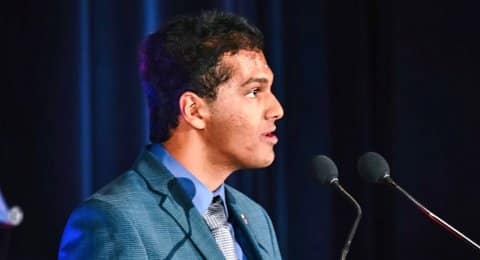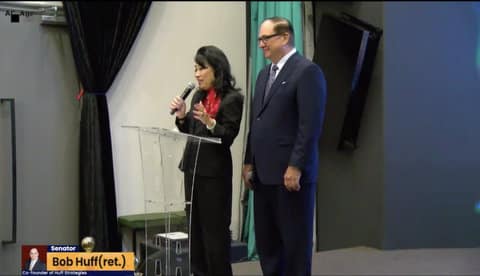
26 Jun The Role of Education in Eradicating Hate

Utkarsh Jain, a UC Berkeley junior, was among a group of high school and college students who spoke about efforts to promote greater inclusivity on campus.
By Selen Ozturk, Ethnic Media Services
While students are often described as tomorrow’s leaders, many are taking leadership roles at the high school and college level today to address the perpetuation of hate in academic environments.
At a briefing held by the ACT Against Hate Alliance and hosted by AAHA founders Mei Mei Huff and former California Sen. Bob Huff, high school and university student leaders across the United States shared their experiences promoting inclusivity in their academic environments.
Social Media and the Effect of Hate on Students
Opening the briefing, Chase Masterson — actress and founder of the bullying prevention nonprofit Pop Culture Hero Coalition — shared statistics illustrating the effect of hate upon students in recent years.
Before the pandemic, she said, the Centers for Disease Control and Prevention reported that one in five children had a mental, behavioral or emotional disorder, while only 20% of these children received care from a mental health provider.
From 2019 to 2021, emergency department visits for suspected suicide attempts increased by 51% for adolescent girls and 4% for adolescent boys per the CDC.
>>>Read: Kids Continue to Suffer in Mental Health ‘Shadow Pandemic’
U.S. Surgeon General Dr. Vivek Murthy “associates this mental health crisis with the difficulties of social media children and teens,” Masterson said. “When our worth is seen as only our social media presence and the number of followers we have, which is how a lot of students see it, there’s a real problem in this country.”
Hailey Wells, a high school junior at Sacred Heart Schools in Atherton, California, said she created a current events club at her school in response to “the effects of social media being so polarizing … people not being able to say their views with peace.”
Even at her club, she added, “there’s a lot of hesitation in worrying about what you say and people being upset with you, because there’s not a lot of openness to share your beliefs.”
Nicholas Hernandez, a sophomore at California State University, Fullerton, said, “it’s easy for people to hide behind a screen and criticize other people and not face any repercussions because they’re not doing it in person.”
On his own campus, he said, there are many “instances where organizations will post on social media that another organization was going to be tabling or handing out flyers, and they call on their members to go and harass these people … there really is no open dialogue or tolerance between these groups.”
Promoting Inclusive Dialogues
Aidan Chao, a senior at Flintridge Preparatory School near Pasadena, California, said that one characteristic of “people trying to say they’re inclusive, but who end up being exclusive” is the use of “labels to name people instead of looking at their personal attributes.”
Inclusive dialogue is often precluded by “a blind hatred for a certain group and the fact that people are afraid to communicate with each other, just because they have a preconceived notion,” which is politically divisive, Chao continued.
Hernandez said, “Diversity doesn’t only pertain to being diverse in race or ethnicity, but also diversity in ideas. It’s equally important to have a difference in ideas, to have an open dialogue, to be able to share your own views, and not be worried about being discriminated against or blocked out by other groups solely because of your views.”
Here, too, online discussion often critically precludes this diversity of ideas, said Wells, given that “everyone’s either on one side of social media or the other.” Rather than a “civil discussion about what’s going on or why they disagree with you,” she said, there’s rarely room for more than “hating each other instead of debating.”
Utkarsh Jain, a University of California, Berkeley junior, said he has had “tables flipped over when tabling certain issues, or for certain candidates, because someone just didn’t agree, or they had some preconceived notion of what this candidate might believe in … it shows you that people that preach the most inclusiveness are generally the most intolerant.”
Remy Garcia-Kakebeen, a freshman at Princeton University, said that her own campus incorporated many key conditions for inclusivity: “There’s a lot of discussion, there’s a lot of collaboration, and there’s a lot of openness … and I think that starts with raising awareness.”
Solutions
Aidan Chao said he enrolled “up to 60 members” in a chapter of ACT Against Hate which he began at Flintridge Preparatory. Many of these members have “experienced the especially politically motivated hate that comes with their political beliefs, and often in the name of diversity, equity and inclusion … that rhetoric has led to a lot of unforeseen hate,” he added.
Chao recently worked with the City Council of San Gabriel, California, to unanimously pass a local version of the AAHA-supported Senate resolution SRC15, which, in March 2023, proclaimed every January 28 to be Stand Against Hate Action Day. He is now working with other City Councils within and outside the San Gabriel Valley to pass similar measures.
To combat polarization on high school and college campuses, Jain urged students to make more room in their groups for bipartisan or nonpartisan perspectives and to approach contentious issues by focusing on aspects “that everyone can agree on,” and particularly to have more conversations in-person rather than online.
“In a perfect world, I would not only promote conversation but also understanding,” said Garcia-Kakebeen. “One of the most useful pieces of advice I received from one of my former teachers was to seek to understand before being understood.
“Other perspectives are important to creating a bigger picture of the entire situation,” she continued. “With that bigger picture, it will become easier to work together to solve an issue rather than work against each other.”






No Comments